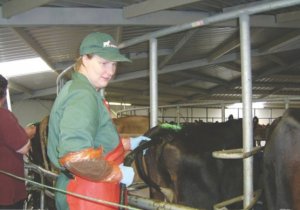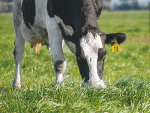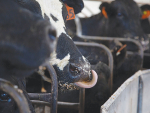DairyNZ is promoting a shift in thinking from the ‘empty rate’ to the ‘six week in calf rate’ – a case of the glass being half full rather than half empty. This is because the in-calf rate determines next year’s calving rate and calving pattern, milk supply, seasonal feed demands and how much time cows have to get back in-calf.
A six-week in-calf rate is the agreed industry standard for measuring reproductive performance on dairy farms. Empty rate obviously varies with the length of the mating period and cannot be compared easily between farms and years. Non-return rates commonly overestimate in-calf rates by 10% and the extent to which they overestimate varies between farms. Also, the six-week in-calf rate has been shown to be a strong driver of effective farm surplus.
The current average national six-week in-calf rate is 60%, however the top 10% of farms achieve 78% or better. DairyNZ’s computer modelling suggests that for every 1% increase in the six-week in-calf rate, profit is increased by $3.34 per cow.
So how do you determine your six-week in-calf rate if this information is so critical? Early scanning is the key. The earliest the six-week in-calf rate can be determined is 10 weeks after the start of AB. The following calendar is a good indicator of when this is likely to be based on the start of AB.
By scanning we can identify a pregnancy as early as 30 days after conception. Accurate dating of the foetus, and therefore accurate calving dates, are best determined 30-90 days after conception. Advantages of the six-week in-calf scan:
Confirmation of AB sires (replacement calves) and natural sires (terminal calves).
Confirm date of pregnancy: early dating confirms which animals have held to AB.
Accurate dating between 30 and 90 days.
Calving spread of herd for feed budget purposes.
Identify non-cycling cows (anoestrus) while bulls are still in the herd.
When measuring reproductive performance, it is the proportion of cows in calf early that is the critical figure. Cows have a natural tendency to get later in calf every year, so the more cows you can keep earlier the more sustainable your farming business will be. Having a scanning plan in place makes a lot of economic sense.
Armed with early scanning results, farmers also have the opportunity to leave the bull in longer, increase bull numbers, sort the herd so all bull power is in the cows not confirmed pregnant, change bulls or continue AB for longer if necessary. The in-calf rate impacts greatly on the success of not only the coming season but often many seasons after that.
In addition to early scanning, subsequent scans – generally 30 days or more after the bulls have been removed – will confirm cows that are in-calf, also those not previously confirmed and any that were recorded as in-calf from the early scan but that may subsequently have lost the calf. This then allows accurate decisions on selecting cull cows to avoid feed deficits during periods of limited feed and grass growth, and later-calving mobs for grazing or wintering off separately.
Recording results
Just as important as the scanning, is the recording of results. The LIC Minda program is widely used and can be accessed by Ultra-Scan technicians and vets to upload your scanning results direct into your Minda records. Ultra-Scan has also developed an application for Android devices which, when synchronised back into their system, can provide the scan data to farmers by email in PDF format by either ‘days pregnant’ or tag number order. This is generally available the same day of the scan and as with all scanning the aim of the results is to provide farmers with the data they need.
Scanning in general
Scanning is an affordable but critical information source. Cows can be scanned during milking on a rotary platform or between milkings in a herringbone cow shed. 100 to 200 cows can be scanned per hour depending on information required, minimising the time that the cows are away from pasture and reducing loss of milk production. Ultra-Scan will offer multiple scanners on the larger herds to keep the scanning time to a minimum for both stock and farm staff. Scanning takes place in the rectal environment and causes little discomfort to the cow. Using ultra-sound technology the results are instant and accurate.
Scanning services are offered by a range of providers including Ultra-Scan certified technicians.
Tel 0508 858 727
www.ultra-scan.co.nz
• Robyn Edwards is the national franchise manager, Ultra-Scan Ltd.


















